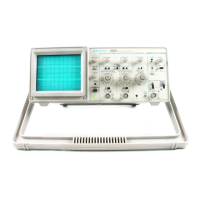Theory of Operation—2205 Service
charged to the 60 V supply, the source-gate voltage
of Q933 is 0 V, turning it off.
Eventually, the 15 V supply comes up. The TURN
OFF signal at the base of Q935 goes LO due to in
sufficient current passing through L950. Transistor
Q932 will now start draining some charge from
C933, reducing the voltage on C933 enough to turn
on Q933. C933 continues to discharge until the
voltage across the source-gate of Q933 reaches 9 V
Causing zeners VR932 and VR933 to conduct.
When the current through L95Q reaches a high
enough value, the TURN OFF signal to Q935 goes HI
(15 V). The 15 V is applied to one end of C933
through Q935. Since the voltage across a capacitor
tiannot change instantly, the voltage at the top end
of C933 makes the same 15 V upward step change.
The voltage at the gate of Q933 is now 6 V higher
than its source (60 V supply), turning Q933 off. The
15 V level also turns off Q932 . When the TURN OFF
signal goes LO, Q932 and Q933 turns on again and
the cycle repeats.
Regulator
The Regulator Circuit senses the -8.6 V from the
secondary of T902 and load current from the in
verter circuit to develop a TURN OFF signal for the
Current Control and Inverter circuits.
The -8.6 V from the secondary is applied to one
end of R916 -8.6 V potentiometer. The potenti
ometer R916 sets the reference voltage for
U9108.The dc error voltage from U910B is filtered
for any ac components by capacitor C925. Zener
VR925 clamps the dc error voltage to 3 V and limits
the amount of load current from the Current Source
to about 3 amps. The dc error voltage is applied to
pin 2 of Comparator U920.
The dc error voltage is proportional to the power
requirements of the load. For instance, an increase
in the load will lower the -8.6 V increasing the ampli
tude of the dc error voltage. An increase in the
ampUtude of the dc error voltage means that more
current is needed to maintain the -8.6 V level.
Load current from Inverter circuitry is converted
to a voltage level by R910 and applied to pin 3 of
U91QA, The voltage amplification of U910A is 1 V per
ampere of load current. This voltage level repre
sents the instantaneous value of load current.
generator U930. This will hold the output of U930 in a
low state and keep Q933 turned on. The load current
will continue to increase until the voltage level on
pin 3 exceeds the dc error voltage on pin 2 causing
the output of U920 to change state from Hi to LO.
This LO is applied to pin 2 (trigger input) of U930.
The TURN OFF signal from the output of U930 goes
HI for a predetermined length of time (about 8 ns).
With the Current Source (Q933) turned off, the
load current voltage from U910A decreases below
the level of the dc error voltage. This will put a high
on the output of U920 and. when U930 times out,
the TURN OFF signal goes back to LO and starts the
cycle over again.
Inverter
The Inverter circuit alternately switches current
through each leg of the primary winding of the out
put transformer T902. This switching action pro
duces ac currents in the secondary windings of the
output transformer. The inverter circuit consists of
D-type, flip-flop switches and power switches con
nected as discrete Darlington pairs.
The TURN OFF signal from U930 clocks D-type
flip-flop U940. The Q and 15 output of U940 are
inverted from each other, and change state only on
the leading edge of the clock signal. Although the on
time of the pulse generator is not identical to the off
time, the period of the on time plus the off time is
the same from one cycle to the next. The output
switching of U940 will produce a square wave with a
50% duty cycle to the inverter switches.
The two outputs of U940 are applied to the
drivers Q939 and Q943. The drivers turn the power
switches (Q941 and Q942) (Q945 and Q946) on and
off alternately to produce an ac voltage in the
secondary winding of the output transformer.
When Q output of U940 goes HI, power switch
Q939 conducts and pulls the collector and one end
of R941 to 0 V. The base of Q941 and Q942 goes to
-2 V causing the emitter-base to become reverse
biased turning the inverter switch off. When Q output
goes LO, Q939 turns off and inverter switch emitter
to base becomes forward biased, turning it on. The
output of performs in the same way as Q output
for the other leg pf the primary winding of the output
transformer. :
Low-Voltage Supplies
The voltage level on pin 3 of U920 is compared
to the dc error voltage on pin 2 of U920. As long as
the voltage level on pin 3 remains below the dc error
voltage on pin 2, the output of U920 will be high. The
high from U920 will not trigger the monostable pulse
The secondary windings of T902 provides various
ac voltages for rectification. The 200 V supply uses
a voltage doubler consisting of CR983, CR984,
C985, and C983. The 100 V is rectified by CR905
and filtered by C984. The diode bridge consisting of
3-16

